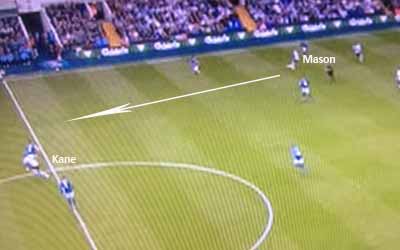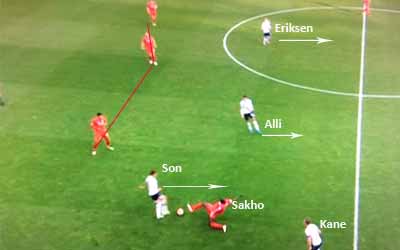The long ball possession game has been used as a nice one-two punch by Spurs this season to catch opponents off-guard.
The long ball game is something that rarely comes up when analysts are talking about Spurs, but it has simmered under our play all season. Whether this has been the more noticeable raking passes of Toby Alderweireld or the subtler switches from Eric Dier, the long ball game to move possession has been prevalent throughout.
The long ball possession game
It’s not just the play of Alderweireld or Dier; there is a deeper side to this long ball game. Mauricio Pochettino also uses the tactic as a way to get quickly on the opposition’s back line through an almost dump and chase approach. Maybe I’m doing it a bit of a disservice by describing it in those terms, but we’ve regularly seen us sending the ball long downfield looking for one of two outcomes.
The first outcome is that we spring an attacker, as it works as just a quick back to front through ball. Harry Kane running on to this searching pass from Ryan Mason early in the season against Everton is one such example.

The second outcome is that it causes a defensive error. This can be from the defensive player trying to clear and miscuing the ball. Or, as the defender tries to bring the ball down, we pounce on him to force a turnover.
Both situations rely on the defensive player not having the skill or nerve to control that particular situation effectively. He is panicked in to an error.
Good examples of this long ball tactic in order to regain possession quickly downfield from a defensive error are littered throughout our season.
In our 1-1 draw with Liverpool, this clip shows how we send the ball downfield from Toby Alderweireld. Mamadou Sakho tries to intercept the ball and bring it down, but is stripped by Son who sets Kane on his way.
Another clip this time from our 3-0 win over Bournemouth shows how we scored our third goal from this exact same tactic too.
Toby Alderweireld goes long downfield and the ball is half cleared by the Bournemouth centre back, who cannot control his header. Erik Lamela scoops up the error and we have regained possession much higher up. Having won the ball back, and with the defence now off-balance, it goes to Kane for the shot and Eriksen hoovers up the rebound.
Our first goal in the 3-0 romp over Man Utd at WHite Hart Lane was also scored in this manner.
The initial long ball downfield was miss-controlled by Daley Blind. Both he and Chris Smalling go up for the same ball and get in each other’s way. Again, the defence has now lost control of the situation. Erik Lamela then jumps on the error. We have now gained possession in a much higher and dangerous area of the pitch from the initial long ball. With the defence now all over the place, we are off on the attack.
Backup between the lines
This long ball tactic to quickly regain possession higher up the field is an extremely effective one as it is backed up by getting men in-between the lines.
Mauricio Pochettino coaches that the ball is sent forward and then we have our advanced midfield trio looking to hoover up the miscues and half-clearances. This is why Erik Lamela has had a really great season. He gets in-between the lines and is tigerish in winning these second balls from the defensive errors – as he was on the goals above against Man Utd and Bournemouth.
Here, in our 2-0 win against Aston Villa, we can see Lamela again lurking between the lines, along with Alli and Eriksen, as a long ball downfield is miscued straight up in the air by Joleon Lescott.

Having players that can get first to these loose balls to regain possession sets us on our way against an exposed defence that is unable to get itself set-up in time.
We can again see this on the Sakho error against Liverpool. Son Heung-Min grabs the ball from the miscontrol and Alli and Eriksen were in the space between the lines along with him.

Once the ball is recovered by one of the advanced midfield trio, that player then has options as he has other runners with him.
Long ball possession overall
Whilst it might not be the prettiest football, this tactic has been extremely effective this season in order to gain possession quickly up the pitch.
It puts pressure on the opposition’s back line and examines if they have the nerve to control long ball situations under duress.
Overall, it serves as a nice change of pace against the pure passing football that we regularly see, an effective one-two tactical punch.
